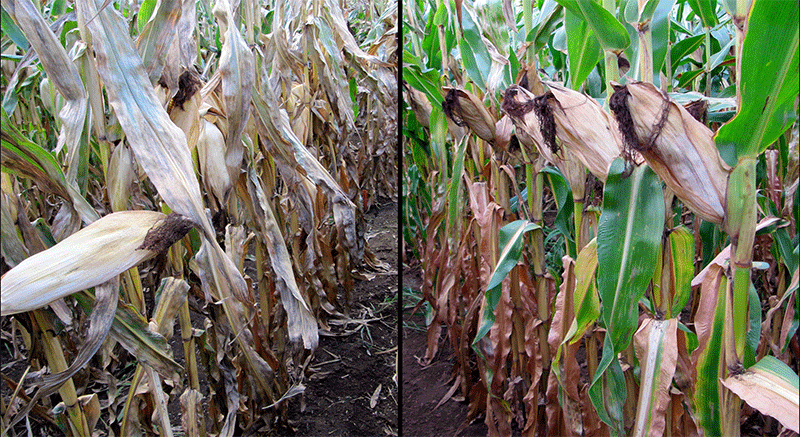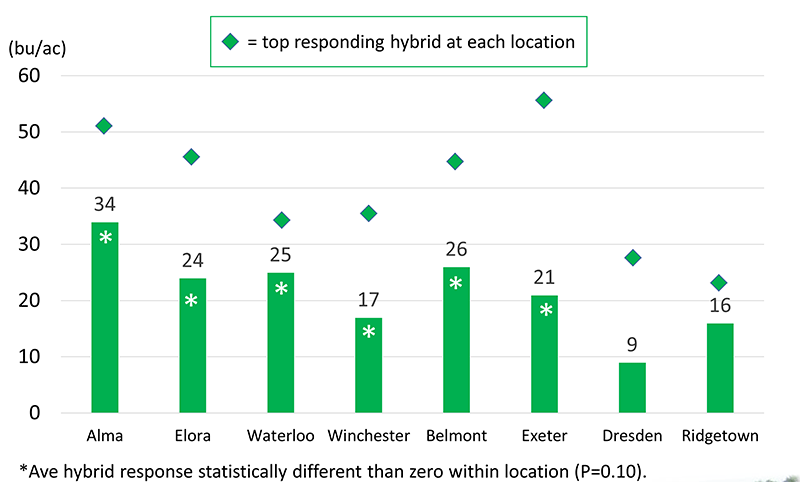Corn hybrid performance on trial
MEASURING INTENSIVE MANAGEMENT
IF YOU KNEW one corn hybrid would respond better to more nitrogen or higher plant populations, would you throw the groceries at it? Would you choose hybrids based on this knowledge? In a time of tight margins, wouldn’t it be helpful to know which hybrids would perform just fine without added inputs? Most farmers would answer, “Yes, of course!” to these questions, but, until now, there hasn’t been a way to assess a hybrid’s performance under intensive management.
PHOTO: VISUAL “STAY GREEN” IN LATE SEPTEMBER WITH A FOLIAR FUNGICIDE. LEFT – NO FUNGICIDE, RIGHT – FUNGICIDE @?VT.

FIGURE 1: YIELD RESPONSE TO INTENSIVE MANAGEMENT ACROSS LOCATIONS.

Last year, the Ontario Corn Committee trials featured a brand new aspect to the trial: hybrid-specific responses to three management components. Until 2015, the corn hybrid performance trials had treated each hybrid line the same — a combination of 32,000 plants per acre, with between 110 and 170 pounds per acre of nitrogen (dependent on soil test results), and without a fungicide application.
In 2015, however, 62 hybrids over eight locations and on 992 plots were treated differently. As Dr. Dave Hooker, field crop agronomist with the University of Guelph-Ridgetown explains, the basic management package was ramped up to include an additional 6,000 plants per acre for a total of 38,000, another 50 lb/ac of nitrogen (N), and a single fungicide application at silking.
FIRST-YEAR RESULTS
The first year’s results have been tabulated, and the results are encouraging.
“Our more northerly test plots (Alma and Elora) showed a 29 bushel response, on average, with one hybrid delivering a 54 bushel response to the intensive management package,” says Hooker. At Ridgetown and Dresden, however, there wasn’t a significant difference in response among hybrids.
The average cost of the intensive package, Hooker says, was about 16 bushels worth of corn (at $5 a bushel), and that investment, on average, resulted in 34 more bushels at the Alma location. Even with a slightly lower corn price, the pay off was well worth it for the hybrids that showed a response.
Where did the added yield come from? The trial suggests that the ‘stay green effect’ contributed to higher yield, as hybrid lines treated at silking maintained more green-leaf surface area and remained greener longer, adding to grain fill. The stay-green effect isn’t just a function of fungicide use, however, as Hooker says it’s also dependent on available nitrogen (rates were higher in the intensively-managed plots) and genetics.
“Some hybrids had as much as 21% disease severity, so staying green has an impact (on grain yield) but there would be some physiological effects of the disease itself, too,” Hooker says.
The big question is, however, will these hybrid-specific responses be consistent year-over-year? That’s what needs to be put to the test by continuing the trialing process, Hooker says. If the trials can establish which hybrids will consistently make use of the extra inputs, farmers can better fine tune the hybrids they select, whether they may be responders or non-responders to higher population, extra N and fungicide, or where they should invest their input dollars.
NON-RESPONDERS
While it’s valuable to know which hybrids show an economic response to the added inputs, it’s perhaps just as valuable to learn which hybrids perform well without them. If margins are thin or input dollars tight, wouldn’t it be great to know where could you save and know you were still maximizing yield?
“There is value in selecting hybrids that produce high yields without the reliance of spending more on intensive inputs. These trials also identify those hybrids,” Hooker says.
Hooker also notes that the trial looked at differences between full-season and lower corn heat unit hybrids, and some farmers may be surprised to learn that there were no response differences among short and long season hybrids.
There are definitely some interesting findings in this preliminary data, but Hooker cautions that this is the first year only of the trial. One year of results isn’t enough to inform your hybrid choices, however the intensive management response will be tested again in 2016.
Experiments are usually repeated across several environments in order to gain some confidence that the results may also occur on farm fields. “Plant breeders and seed companies test new hybrids for stability of grain yield and other traits in multiple environments,” Hooker says. “Top performing hybrids are often identified very quickly; we can apply the same process to identify hybrid-specific responses to management.”
Going forward, the plan for 2016 is to include the same hybrids as 2015 for each field trial location, which will produce results across 4 location-years of data.
Editor’s Note: You can find all the corn hybrid data, including more details on the intensive management trials at GoCorn.net. •


















